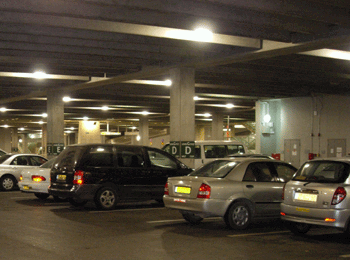
When
family comes to town, I tend to find myself in the car, driving,
more than usual: to and from various restaurants for meals, off for tiyulim, shopping downtown. That was certainly the case in the last two weeks as twelve-year-old Merav celebrated her bat mitzvah.
Now, with family safely back in North America and life here settling
back to normal, I had a little time to think about my time behind the
wheel, and in particular the changing relationship between Israel and
automobiles. The conclusion, as anyone who has tried navigating this
little country of ours will agree, is inescapable:
Israel just wasn’t made for cars.
Which was OK until fairly recently because there weren’t a lot of cars around in the first place.
When I first visited Israel in the mid-1980s as a student, riding in a car, at least one that wasn’t a taxi, was a big deal.
“You have a car? Could you give me a ride?”
‘Where are you going?”
“Doesn’t matter. I’ll just sit for a few minutes, if that’s OK?”
Coming from car-crazy California, Israel of 20 years ago was like joining a 12-step program for auto-aholics.
Times have changed and today, everyone has a car. And very often two. And that’s where our latest problems start.
There just isn’t room on the highways to drive all those cars, hence
traffic jams that only get worse each year. Most of our main freeways
were built with only two lanes in each direction, maybe three if the
planners were particularly forward thinking. Half of the numerous
public works projects going on all over the country, it seems, are for
adding lanes to existing highways.
Of course, it won’t be long before those aren’t enough.
But what does it matter if the roads are improved if there isn’t room in the neighborhoods and offices to park them all?
Even new cities like Modi’in that were planned when cars were already
the rage only allocated 1.2 parking spaces per apartment. Don’t ask me
what the planners were thinking. Of course, as a commuter town with no
industry of its own to speak of, everyone has two cars.
So where do they put them? The answer is clear to anyone trying to take a leisurely stroll: on the sidewalk.
Doesn’t matter where you are in the country, the sidewalks are just a
second row of parking. I don’t mean that people park perpendicularly,
sticking the car nose onto the pedestrian walkway. Rather they do a
full parallel park on the sidewalk proper. I actually think people
prefer to park on the sidewalk. After all, it’s the closest you can get
to your destination. To walk even a meter further would make one a freier, a sucker.
Still, it’s an infuriating practice, especially when you’re walking
with your kids, maybe a stroller, and you have to veer into the street
every few meters just to pass.
Sure, there’s a law against it. But what policeman has time to enforce parking procedures when there are terrorists to stop.
Part of the problem is the way that people get their cars in Israel. I
read somewhere once that more than 50% of the country’s rolling stock
is actually a benefit given to employees from their companies. Work
compensation, at least in hi-tech, routinely consists of a salary, a
cellphone, health benefits…and a car.
You can tell which cars belong to which companies because they sport
the company’s logo in a large sticker plastered on both sides near the
rear of the car.
Companies that give their employees a car as a benefit pick up both the
insurance and the gas. The system is so ingrained that Israeli service
stations have a special gas pump that connects wirelessly to a chip in
the car and automatically calculates the price without ever requiring a
shekel or credit card to change hands.
Everyone knows that carpools and public transit could significantly
alleviate the problem. But in an age when buses are known to blow up,
many people I know who used to catch Egged to work now drive or take
taxis.
To wit: Jerusalem has recently been adding exclusive busways
to some of
its busier streets as the first stage in a broader plan to build a
light rail in the city. The thing is, I never seen any buses in the
busways. The
only thing for sure is that the line of traffic jammed up in what
little’s left for private cars suggests that “Field of Dreams” adage
“if you build it they will come” may not apply to public transit in our
nation’s capital.
Still in your car? Parking at the office poses no less of a creative
challenge than back home. Many companies have solved this by hiring a
full-time employee whose sole job is to double park cars in the
corporate lot. I’ve even seen double stackers which lift one car up
into the air so another can park underneath.
Don’t get me wrong. I’m happy to kvetch, but this certainly isn’t a reason to leave the country. And things are slowly getting better.
The public parking lot in Tel Aviv’s Azrieli Shopping Center is as
spacious as any in North America, with color-coding throughout,
pay-before-you-leave machines, ample lighting, and escalators that
really work, whisking you into the center itself. The parking lot
at Ben Gurion Airport’s new Terminal 3 (pictured above) is a similar joy.
Indeed, to find a well-designed parking lot can be so exciting, it’s
sometimes worth the trip alone. Forget the mall upstairs, I came to
park.
That is, if you don’t mind the traffic getting there…and the fact that
when you get back home you’ll probably have to park on the sidewalk
again.


{ 1 comment… read it below or add one }
This entry made me laugh so much!
We had similar problems in Sharjah, a neighbor emirate of Dubai in the United Arab Emirates, when we lived in Sharjah. Our building was surrounded by a used-car market on 3 sides and a main road on the fourth. The used-car market was illegal and the companies even used the sidewalk to park their cars, so we were left with no choice but to park in sand. Yay!